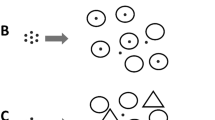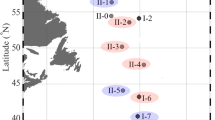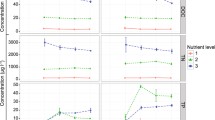Abstract
Dialysis bags were used to examine the impact of predation and viral lysis on prokaryotic community composition (PCC) over a 5-day experiment in the oligomesotrophic Lake Pavin (France). The impact of the different predator communities (protists and metazoans) of prokaryotes was estimated by water fractionation (<5 μm: treatment filtered on 5 μm, without ciliates and metazoans; UNF: unfiltered treatment with all planktonic communities). Enrichments of natural viruses (<1.2 μm: with a natural virus concentration; <1.2 μm V and VV: with enrichment leading to a double or triple concentration of viruses, respectively) were used to indirectly assess the control of virioplankton. Viral activity was estimated from the frequency of visibly infected cells (FVIC). PCC was determined by fluorescence in situ hybridization (FISH) and terminal restriction fragment length polymorphism (T-RFLP). In this study, PCC was affected by the eukaryote communities (especially flagellates), and viruses to a lesser extent. Cyanobacteria declined significantly during the experiment and were highly correlated with the FVIC. In addition, the 503-bp terminal restriction fragment (T-RF) disappeared in treatments with virus enrichments, suggesting possible viral-associated mortality processes, whereas the 506-bp T-RF was not affected in these treatments. On one hand, these results suggest a control of the PCC: first, by viral lysis of some dominant phylotypes and second, by interspecific competition between resistant strains for the uptake of substrates released by this lysis. The increase of Archaea may suggest that these cells benefit such resources. On the other hand, the disappearance and the stable proportion of some dominant phylotypes suggested a selection pressure due to the predatory activity on prokaryotes. In conclusion, prokaryotic abundance appears to be mainly controlled by flagellate protists, which also affected PCC, whereas viruses seemed to be essentially responsible for profound changes in PCC via direct and indirect actions.






Similar content being viewed by others
References
RI Amann BJ Binder RJ Olson SW Chisholm R Devereux DA Stahl (1990) ArticleTitleCombination of 16S rRNA-targeted oligonucleotide probes with flow cytometry for analysing mixed microbial populations Appl Environ Microbiol 56 1919–1925 Occurrence Handle2200342 Occurrence Handle1:CAS:528:DyaK3cXkvFCgsrs%3D
F Azam T Fenchel JG Field JS Gray LA Meyer F Thingstad (1983) ArticleTitleThe ecological role of water column microbes in the sea Mar Ecol Prog Ser 10 257–263
AK Bej (1995) PCR amplification of DNA recovered from the aquatic environment JT Trevors JD Elsas Particlevan (Eds) Nucleic Acids in the Environment: Methods and Applications Springer Berlin Heidelberg New York 179–218
O Bergh KY Børsheim G Bratbak M Heldal (1989) ArticleTitleHigh abundance of viruses found in aquatic environments Nature 340 467–468 Occurrence Handle2755508 Occurrence Handle10.1038/340467a0 Occurrence Handle1:STN:280:DyaL1MzjtVGqsw%3D%3D
Y Bettarel T Sime-Ngando C Amblard H Laveran (2000) ArticleTitleA comparison of methods for counting viruses in aquatic systems Appl Environ Microbiol 66 2283–2289 Occurrence Handle10831400 Occurrence Handle10.1128/AEM.66.6.2283-2289.2000 Occurrence Handle1:CAS:528:DC%2BD3cXjvFWgur0%3D
Y Bettarel T Sime-Ngando C Amblard J-F Carrias D Sargos F Garabétian P Lavandier (2002) ArticleTitleThe functional importance of bacteriophages in the microbial loop of an oligomesotrophic lake over a diel cycle Ann Limnol 38 263–269
Y Bettarel T Sime-Ngando C Amblard J Dolan (2004) ArticleTitleViral activity in two contrasting lake ecosystems Appl Environ Microbiol 70 2941–2951 Occurrence Handle15128555 Occurrence Handle10.1128/AEM.70.5.2941-2951.2004 Occurrence Handle1:CAS:528:DC%2BD2cXktlCnsbY%3D
J Boenigk C Matz K Jürgens H Arndt (2002) ArticleTitleFood concentration-dependent regulation of food selectivity of interception-feeding bacterivorous nanoflagellates Aquat Microb Ecol 27 195–202
DA Caron (1983) ArticleTitleTechnique for enumeration of heterotrophic and phagotrophic nanoplankton, using epifluorescence microscopy, and comparison with other procedures Appl Environ Microbiol 46 491–498 Occurrence Handle16346372 Occurrence Handle1:STN:280:DC%2BC3crnvFyqtw%3D%3D
J-F Carrias J-P Serre T Sime-Ngando C Amblard (2002) ArticleTitleDistribution, size, and colonization of pico- and nano-detrital organic particles (DOP) in two lakes of different trophic status Limnol Oceanogr 47 1202–1209 Occurrence Handle1:CAS:528:DC%2BD38XmtVWhurk%3D Occurrence Handle10.4319/lo.2002.47.4.1202
T Castberg A Larsen RA Sandaa CPD Brussaard J Egge M Heldal A Paulina R Thyrhaug EJ Hannen Particlevan G Bratbak (2001) ArticleTitlePopulation dynamics and diversity during a bloom of the marine coccolithophorid Emiliana huxleyi (Haptophyta) Mar Ecol Prog Ser 221 39–46
JA Fuhrman F Azam (1982) ArticleTitleThymidine incorporation as a measure of heterotrophic bacterioplankton production in marine surface waters. Evaluation and field results Mar Biol 66 109–220 Occurrence Handle10.1007/BF00397184
JA Fuhrman AA Davis (1997) ArticleTitleWidespread Archaea and novel bacteria from the deep sea as shown by 16S rRNA gene sequences Mar Ecol Prog Ser 150 275–285
FO Glöckner R Amann A Alfreider J Pernthaler R Psenner K Trebesius K-H Schleifer (1996) ArticleTitleAn in-situ hybridization protocol for detection and identification of planktonic bacteria Syst Appl Microbiol 19 403–406
FO Glöckner E Zaichikov N Belkova L Denissova J Pernthaler A Pernthaler R Amann (2000) ArticleTitleComparative 16S rRNA analysis of lake bacterioplankton reveals globally distributed phylogenetic clusters including an abundant group of Actinobacteria Appl Environ Microbiol 66 5053–5065 Occurrence Handle11055963
MW Hahn MG Höfle (2001) ArticleTitleGrazing of protozoa and its effect on populations of aquatic bacteria FEMS Microbiol Ecol 35 113–121 Occurrence Handle11295449 Occurrence Handle1:CAS:528:DC%2BD3MXisF2rsLk%3D
GJ Herndl E Kaltenböck G Müller-Niklas (1993) Dialysis bag incubation as a nonradiolabeling technique to estimate bacterioplankton production in situ PF Kemp BF Sherr EB Sherr JJ Cole (Eds) Handbook of Methods in Aquatic Microbial Ecology Lewis Publishers Boca Raton 553–556
CM Horner-Devine MA Leibold VH Smith BJM Bohannan (2003) ArticleTitleBacterial diversity patterns along a gradient of primary productivity Ecol Lett 6 613–622
L Jardillier M Basset I Domaizon A Belan C Amblard M Richardot D Debroas (2004) ArticleTitleBottom-up and top-down control of the bacterial community composition in the euphotic zone of a reservoir Aquat Microb Ecol 35 259–273
Jardillier, L, Boucher, D, Personnic, S, Jacquet, S, Thénot, A, Sargos, D, Amblard, C, Debroas, D. Relative importance of nutrients and mortality factors on prokaryotic community composition in two lakes of different trophic status: microcosm experiments. FEMS Microb Ecol (in press)
J Jürgens J Pernthaler S Schalla R Amann (1999) ArticleTitleMorphological and compositional changes in a planktonic bacteria community in response to enhanced protozoan grazing Appl Environ Microbiol 65 1241–1250 Occurrence Handle10049890
CH King RW Sanders EB Shotts KG Porter (1991) ArticleTitleDifferential survival of bacteria ingested by zooplankton from a stratified eutrophic lake Limnol Oceanogr 36 829–845 Occurrence Handle10.4319/lo.1991.36.5.0829
DJ Lane (1991) 16S/23S rRNA sequencing E Stackebrandt M Goodfellow (Eds) Nucleic Acid Techniques in Bacterial Systematic Wiley New York 115–117
S Langenheder K Jürgens (2001) ArticleTitleRegulation of bacterial biomass and community structure by metazoan and protozoan predation Limnol Oceanogr 46 121–134 Occurrence Handle10.4319/lo.2001.46.1.0121
WT Liu TL Marsh H Cheng LJ Forney (1997) ArticleTitleCharacterization of microbial diversity by determining terminal restriction fragment length polymorphisms of genes encoding 16S rRNA Appl Environ Microbiol 63 4516–4522 Occurrence Handle9361437 Occurrence Handle1:CAS:528:DyaK2sXnt12ntbs%3D
W Manz R Amann W Ludwig M Wagner KH Schleifer (1992) ArticleTitlePhylogenic oligodeoxynucleotide probes for the major subclasses of proteobacteria: Problems and solutions Syst Appl Microbiol 15 593–600
W Manz R Amann W Ludwig M Vancanneyt K-H Schleifer (1996) ArticleTitleApplication of a suite of 16S rRNA-specific oligonucleotide probes designed to investigate bacteria of the phylum Cytophaga–Flavobacter–Bacteroides in the natural environment Microbiology 142 1097–1106 Occurrence Handle8704951 Occurrence Handle1:CAS:528:DyaK28XjtFyju7c%3D Occurrence Handle10.1099/13500872-142-5-1097
R Maranger DF Bird (1995) ArticleTitleViral abundance in aquatic systems: a comparison between marine and fresh waters Mar Ecol Prog Ser 121 217–226
R Massana K Jürgens (2003) ArticleTitleComposition and population dynamics of planktonic bacteria and bacterivorous flagellates in seawater chemostat cultures Aquat Microb Ecol 32 11–22
C Matz K Jürgens (2003) ArticleTitleInteraction of nutrient limitation and protozoan grazing determines the phenotypic structure of a bacterial community Microb Ecol 45 384–398 Occurrence Handle12704556 Occurrence Handle10.1007/s00248-003-2000-0 Occurrence Handle1:STN:280:DC%2BD3s3msFyksQ%3D%3D
C Matz J Boenigk H Arndt K Jürgens (2002) ArticleTitleRole of bacterial phenotypic traits in selective feeding of the heterotrophic nanoflagellate Spumella sp. Aquat Microb Ecol 27 137–148
M Middelboe (2000) ArticleTitleBacterial growth rate and marine virus–host dynamics Microb Ecol 40 114–124 Occurrence Handle11029080
M Middelboe PG Lyck (2002) ArticleTitleRegeneration of dissolved organic matter by viral lysis in marine microbial communities Aquat Microb Ecol 27 187–194
M Middelboe A Hagström N Blackburn B Sinn U Fischer NH Borch J Pinhassi K Simu MG Lorenz (2001) ArticleTitleEffects of bacteriophages on the population dynamics of four strains of pelagic marine bacteria Microb Ecol 42 395–406 Occurrence Handle12024264 Occurrence Handle10.1007/s00248-001-0012-1 Occurrence Handle1:CAS:528:DC%2BD38Xks1w%3D
AG Murray (1995) ArticleTitlePhytoplankton exudation: exploitation of the microbial loop as a defence against algal viruses J Plankton Res 17 1079–1094
AG Murray GA Jackson (1992) ArticleTitleViral dynamics: a model of the effects of size, shape, motion and abundance of single-celled planktonic organisms and other particles Mar Ecol Prog Ser 89 103–116
RT Noble M Middelboe JA Fuhrman (1999) ArticleTitleEffects of viral enrichment on the mortality and growth of heterotrophic bacterioplankton Aquat Microb Ecol 18 1–13
L Øvreås D Bournde RA Sandaa E Casamayor S Benlloch V Goddard G Smerdon M Heldal TF Thingstad (2003) ArticleTitleResponse of bacterial and viral communities to nutrient manipulations in seawater mesocosms Aquat Microb Ecol 31 109–121
J Pernthaler T Posch K Simek J Vrba R Amann R Psenner (1997) ArticleTitleContrasting bacterial strategies to coexist with a flagellate predator in an experimental microbial assemblage Appl Environ Microbiol 63 596–601 Occurrence Handle1:CAS:528:DyaK2sXhtVKku74%3D Occurrence Handle16535516
MF Polz CM Cavanaugh (1998) ArticleTitleBias in template-to-product ratios in multitemplate PCR Appl Environ Microbiol 64 3724–3730 Occurrence Handle9758791 Occurrence Handle1:CAS:528:DyaK1cXms1entrc%3D
T Posch K Šimek J Vrba J Pernthaler J Nedoma B Sattler B Sonntag R Psenner (1999) ArticleTitlePredator-induced changes of bacterial size-structure and productivity studied on an experimental microbial community Aquat Microb Ecol 18 235–246
M Richardot D Debroas LB Jugnia R Tadonléké L Berthon J Dévaux (2000) ArticleTitleChanges in bacterial processing and composition of dissolved organic matter in a newly-flooded reservoir (a three-year study) Arch Hydrobiol 148 231–248
MS Schwalbach I Hewson JA Fuhrman (2004) ArticleTitleViral effects on bacterial community composition in marine plankton microcosms Aquat Microb Ecol 34 117–127
T Sime-Ngando JP Mignot C Amblard G Bourdier C Desvilettes C Quiblier-Lloberas (1996) ArticleTitleCaractérisation des particules virales planctoniques dans un lac du Massif Central français: aspects méthodologiques et premiers résultats Ann Limnol 32 1–5 Occurrence Handle10.1051/limn/1996025
K Šimek J Pernthaler MG Weinbauer K Horòák JR Dolan J Nedoma M Mašín R Amann (2001) ArticleTitleChanges in bacterial community composition and dynamics and viral mortality rates associated with enhanced flagellate grazing in a mesoeutrophic reservoir Appl Environ Microbiol 67 2723–2733 Occurrence Handle11375187
DS Srivastava J Kolasa J Bengtsson A Gonzalez SP Lawler TE Miller P Munguia T Romanuk DC Schneider MK Trzcinski (2004) ArticleTitleAre natural microcosms useful model systems for ecology Trends Ecol Evol 19 379–384 Occurrence Handle10.1016/j.tree.2004.04.010 Occurrence Handle16701289
DA Stahl R Amann (1991) Development and application of nucleic acid probes E Stackebrandt M Goodfellow (Eds) Nucleic acid techniques in bacterial systematics Wiley Chichester 205–248
CA Suttle AM Chan (1994) ArticleTitleDynamics and distribution of cyanophages and their effects on marine Synechococcus spp. Appl Environ Microbiol 60 3167–3174 Occurrence Handle16349372 Occurrence Handle1:STN:280:DC%2BC3crot1Oksw%3D%3D
CA Suttle AM Chan MT Cottrell (1991) ArticleTitleUse of ultrafiltration to isolate viruses from seawater which are pathogens of marine phytoplankton Appl Environ Microbiol 57 721–726 Occurrence Handle16348439 Occurrence Handle1:STN:280:DC%2BC3crotFylsQ%3D%3D
MT Suzuki SJ Giovannoni (1996) ArticleTitleBias caused by template annealing in the amplification of 16S rRNA genes by PCR Appl Environ Microbiol 62 625–630 Occurrence Handle8593063 Occurrence Handle1:CAS:528:DyaK28XovVCrug%3D%3D
TF Thingstad R Lignell (1997) ArticleTitleTheoretical models for the control of bacterial growth rate, abundance, diversity and carbon demand Aquat Microb Ecol 13 19–27
H Utermöhl (1958) ArticleTitleZur Vervollkommung der quantativen Phytoplankton Methodik Mitt Int Ver Limnol 9 1–38
JB Waterbury FW Valois (1993) ArticleTitleResistance to co-occurring phages enables marine Synechococcus communities to coexist with cyanophages abundant in seawater Appl Environ Microbiol 59 3393–3399 Occurrence Handle16349072 Occurrence Handle1:STN:280:DC%2BC3crot1CksA%3D%3D
MG Weinbauer (2004) ArticleTitleEcology of prokaryotic viruses FEMS Microbiol Rev 28 127–181 Occurrence Handle15109783 Occurrence Handle10.1016/j.femsre.2003.08.001 Occurrence Handle1:CAS:528:DC%2BD2cXjsVentLw%3D
MG Weinbauer P Peduzzi (1995) ArticleTitleEffect of virus-rich high molecular weight concentrates of seawater on the dynamics of dissolved amino acids and carbohydrates Mar Ecol Prog Ser 127 245–253 Occurrence Handle1:CAS:528:DyaK28Xmt1aktQ%3D%3D
MG Weinbauer F Rassoulzadegan (2004) ArticleTitleAre viruses driving microbial diversification and diversity Environ Microbiol 6 1–11 Occurrence Handle14686936 Occurrence Handle10.1046/j.1462-2920.2003.00539.x
MG Weinbauer U Christaki J Nedoma K Šimek (2003) ArticleTitleComparing the effects of resource enrichment and grazing on viral production in a meso-eutrophic reservoir Aquat Microb Ecol 31 137–144
C Winter A Smit GJ Herndl MG Weinbauer (2004) ArticleTitleImpact of virioplankton on Archaeal and Bacterial community richness as assessed in seawater batch cultures Appl Environ Microbiol 70 804–813 Occurrence Handle14766558 Occurrence Handle10.1128/AEM.70.2.804-813.2004 Occurrence Handle1:CAS:528:DC%2BD2cXhs1Churo%3D
KE Wommack RR Colwell (2000) ArticleTitleVirioplankton: viruses in aquatic ecosystems Microbiol Mol Biol Rev 64 69–114 Occurrence Handle10704475 Occurrence Handle1:STN:280:DC%2BD3c7ntF2jsw%3D%3D
KE Wommack J Ravel RT Hill RR Colwell (1999) ArticleTitleHybridization analysis of Chesapeake Bay virioplankton Appl Environ Microbiol 65 241–250 Occurrence Handle9872785 Occurrence Handle1:CAS:528:DyaK1MXjvVyguw%3D%3D
QL Wu J Boenigk MW Hahn (2004) ArticleTitleSuccessful predation of filamentous bacteria by nanoflagellate challenges current models of flagellate bacterivory Appl Environ Microbiol 70 332–339 Occurrence Handle14711660 Occurrence Handle10.1128/AEM.70.1.332-339.2004 Occurrence Handle1:CAS:528:DC%2BD2cXmvFansw%3D%3D
Acknowledgments
We thank Christian Faye and Sébastien Specel for automated sequencer and GENESCAN analysis, Denis Sargos for his technical assistance, Ibrahima Anne, Karel Horňák, and Michal Mašín for their help in the field, and Marie Charpin and Jean-François Carrias for their personal communication of results for picocyanobacteria not shown in this study. This study was supported by contract R-095 SOMIVAL and a CNRS international project (“PICS”).
Author information
Authors and Affiliations
Corresponding author
Rights and permissions
About this article
Cite this article
Jardillier, L., Bettarel, Y., Richardot, M. et al. Effects of Viruses and Predators on Prokaryotic Community Composition. Microb Ecol 50, 557–569 (2005). https://doi.org/10.1007/s00248-005-5030-y
Received:
Accepted:
Published:
Issue Date:
DOI: https://doi.org/10.1007/s00248-005-5030-y




